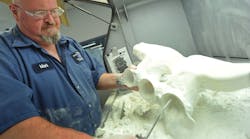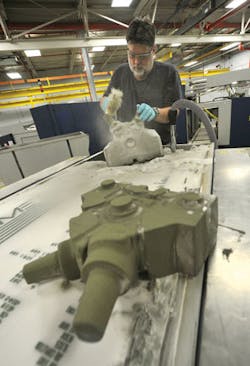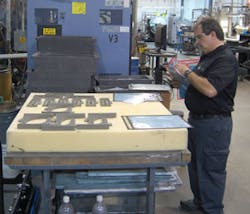Additive manufacturing has been called many things in the last year – disruptor, game-changer, paradigm-shifter, harbinger of the third Industrial Revolution, occasionally the savior of American manufacturing.
Keeping pace with these descriptions, 3-D printing has leapt suddenly out of the workshops, out of the labs, and straight into the mainstream with equipment and services popping up everywhere from Staples to Skymall to the local library.
See Also: Manufacturing Industry Technology News & Trends
According to the 2013 Wohlers Report, the additive manufacturing industry spiked 28.6% last year, bringing its total global value up to some $2.2 billion.
3-D printing, it seems, is suddenly everywhere, suddenly printing everything.
However, for all that growth and promise, all that hope and hype surrounding the industry, on the surface, these hip technologies seem to produce little more than trinkets and models, multicolored mockups and toys.
Of course these prototypes have had some profound impact on engineering and innovation. Without question. But in the grit and heat of the real manufacturing world, down on the factory floor, these plastic models have offered little direct benefit.
But that's just the flashy side.
Behind that flash-and-pop culture appeal, there is the grittier side of additive manufacturing – an industrial 3-D world quietly churning out metal pieces, castings and components integral to the machines and products we use today.
Right now, savvy manufacturers are already adopting these tools – direct laser metal sintering (DLMS), electron beam melting (EBM) and sand printers – to transform their processes into the quick, flexible systems the age demands.
Far from the revolution promised by the hype, these industrial machines are falling in comfortably beside traditional tools, beside the CNCs, grinders, mills and lathes, as an integrated piece of a new industrial landscape – part additive, part subtractive: the new hybrid factory.
And it's there that the manufacturing revolution just may begin.
Driving 3-D
Ford Motor's (IW 500/4) Dearborn, Mich., plant is stocked with the usual assortment of the heavy duty tools necessary to manufacture the cylinder heads, exhaust manifolds and all the intricate parts that compose its EcoBoost engines. In most ways, it is as traditional a machine shop as any other.
Right next door, however, is a relatively new addition: a complete 3-D sand printing laboratory that has been charged with printing the casting molds for the innovative new engine designs that will define the future of the company.
See Also: Additive Manufacturing News & Resources
"On a new engine program, we will print most of the major components on the engine," says Paul Susalla, section supervisor of Ford's rapid manufacturing unit. "Bumper to bumper, roof to wheel, we do everything."
This lab is just one piece of a global focus on additive manufacturing within the Ford enterprise, put in place to help perfect new and experimental engines and car components – and achieving new breakthroughs at an unprecedented pace along the way.
"Additive manufacturing is a huge asset to our global engineers and product development team and in our manufacturing process," says John Fleming, Ford's executive vice president of global manufacturing. "It's difficult to envision being where we are today without the aid of these technologies."
According to Fleming, sand printing – which creates robust, intricate molds by binding together thousands of particle-thin layers of sand – saves the company millions every year.
In the traditional manufacturing process, every new mold costs thousands, sometimes tens of thousands, of dollars to produce.
While developing a new engine, each component is constantly changing as engineers experiment with new designs, fittings and architectures to meet their goals. Each new iteration of the part requires a new mold and every new mold adds thousands more to the cost of the project.
But printing the molds onsite, he says, allows his engineers to create new pieces at the cost of materials – just sand and binding agents – and to print several iterations in the same batch. The savings are huge.
But that's not the best part, Fleming says.
"Saving millions of dollars in the prototyping process is fantastic, but what is really significant is the time savings – that's the ultimate game changer with this technology," he explains. "We're able to get production-level parts in a matter of days, compared with months using traditional methods."
These time savings, he says, afford his team more time to test, more time to engineer and more time to manufacture high-quality parts.
"When you learn about some of the ways [additive manufacturing] has positively impacted, and even in some cases saved, product launches, you begin to understand its value," he says. "Our world-class team is allowed so much more time to innovate and improve products because they have more opportunities to utilize multiple variations more efficiently."
From Prototyping to Manufacturing
3-D printing is nothing new to Ford. As Harold Sears, Ford's additive manufacturing technical specialist, recalls, the company began investing in the technology in its earliest days back in the late 1980s.
"Ford was involved with the folks right from the get-go," he says. "Back then, it was just a couple of guys in a garage in Germany working with an MIT patent. Ford got involved with them and helped push that technology along to help them create the robust machines you can buy today."
And that, says Susalla, is the real difference between the plastic prototyping machines and these industrial-strength technologies. "The equipment we have in my lab and other labs around Ford has been in development for many years, and they are very high-quality, very highly capable machines," he says. "We're already using it extensively in our product development cycle."
According to the recent Wohler's Report, about 28.3% of the total additive manufacturing market value comes from these kinds of machines putting out finished component parts – indicating that what is happening at Ford is really part of a greater movement throughout the industry as these hybrid factories begin to catch hold.
"We're seeing unprecedented interest and activity in the industrial sector," says Terry Wohlers, principal consultant and president of Wohlers Associates, which produces the annual reports.
"The technology has been used for more than two decades mostly just for prototyping, but now we are seeing this transition toward using it for manufacturing quantities," he explains.
So far, he says, the speed of the machines prevents adoption into high-volume production, which, at least for the moment, prevents Ford from printing production parts outright. The exception to this limit, though, Wohler notes, is luxury cars – Lamborghinis, Bentleys and the like – that by nature are low-volume, high-quality products and include a great deal of customization.
And that defines the real niche of production-level industrial additive manufacturing: mass customization.
Printing a Customizable World
Dave Burns, COO and president of additive manufacturer ExOne – which produces Ford's sand printing machines, along with a host of powdered metal printers and parts – sees the technology allowing a new age of mass customization in the industry.
"I hear pundits say that a few years from now, everything will be additively manufactured. That's just naïve," he says. "There is, however, a gap between highly complex, customizable production and simple, high-volume metal bashing. In the middle is where we're going to end up with additive."
The ability to produce customizable, complex parts, he says, is bringing to fruition one of the longest-standing goals of manufacturing: to produce just what the customers want, exactly as they want it, and still make money doing so.
"The ability to, at zero additional cost, truly customize every product you make in the same manufacturing sequence is something we have talked about forever in manufacturing, but there hadn't been a practical way to do it," he says. "Well, now there is."
In his Irwin, Pa., facility, Burns' printers churn out finished metal components for machines and assemblies emblazoned with logos and images, serial numbers and special configurations – all of which is totally impossible using traditional techniques.
This, he says, is the place for additive manufacturing in the industrial world: It can, for the first time, produce these customized, unique or highly intricate pieces that are too expensive to produce otherwise.
And there is one industry, he notes, that is already poised to embrace such a technology: aerospace.
Flying 3-D
In its early days, additive pundits often envisioned a world in which engineers could one day plug some CAD files into a machine, press a button and out would pop a fully functional jet engine – a silly idea, practically speaking, but one that is serious business to engine makers.
"The fact is, you actually can hit a button on a machine today and out will pop a jet engine," says Pratt and Whitney COO, Paul Adams. "Unfortunately it is a plastic desk ornament of a jet engine."
This kind of thinking, he says, ignores the complicated engineering and manufacturing techniques required to build an engine – something additive could never replace. It also highlights one of the major hurdles facing the field.
"The real challenge today is how to go from making the doodads and desk ornaments to actually making a product we feel comfortable putting on a man-rated jet engine," he explains. "That is just the biggest challenge with the technology: the industrialization of it."
To do so, the company focuses on two key technologies – DLMS and EBM. Both technologies work by melting powdered metals – in Pratt's case, primarily nickel and titanium alloys – layer by particle layer into 3-dimensional constructs. The end result is a strong, dense metal part on par with any traditionally machined product – with a few advantages.
"With these technologies, you can make parts that have geometries that are not achievable using investment casting or tooling," Adams says.
One particular example, he notes, is the ability to print complicated, hollow parts.
"In our industry, we're simultaneously trying to achieve cost and weight," he says. "So a technology that allows us to make hollow parts that weigh less and are less expensive to produce is very, very powerful."
Beyond that, he says, the degree of freedom you get with this technology for weight reduction and the ability to optimize the material qualities really "offers a tremendous amount of design feasibility that we currently don't have."
"That's where I think the real payoff long-term of the technology will come from," he explains.
In the meantime, he says, the objective is to focus on continually developing the technology and doing so in a way that maintains quality standards for existing products.
And that, he notes, is counterintuitive to hype.
"The hype guys want to show you the desk ornament," he says. "The ones that are really serious about this, we keep our heads down and really work on product integrity. That way we'll make sure that when we introduce a part, we'll introduce it with the highest level of integrity at a point where it creates value for our customers."
"In the long term," he says, "I think that is the formula for success."






